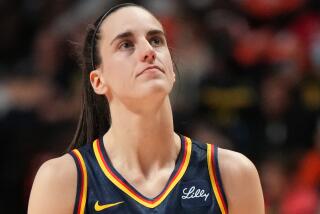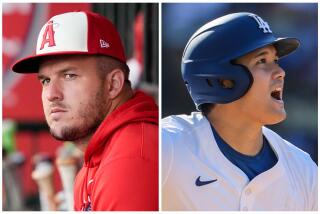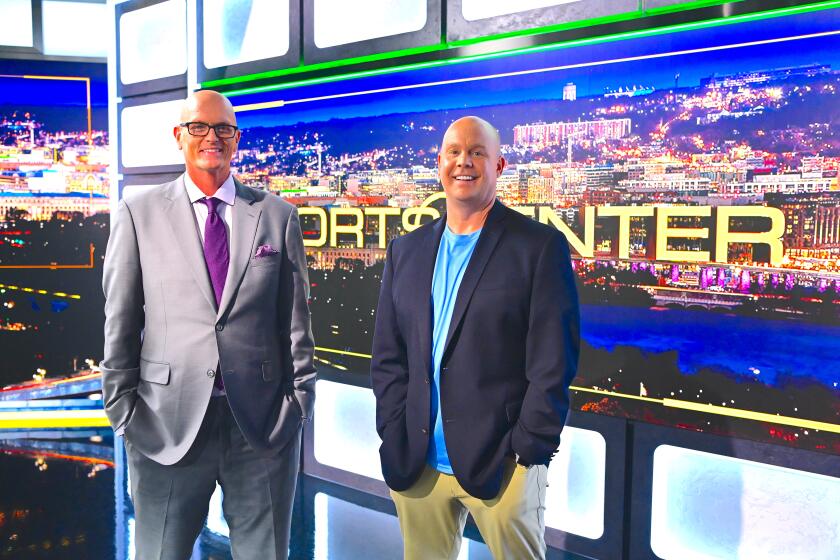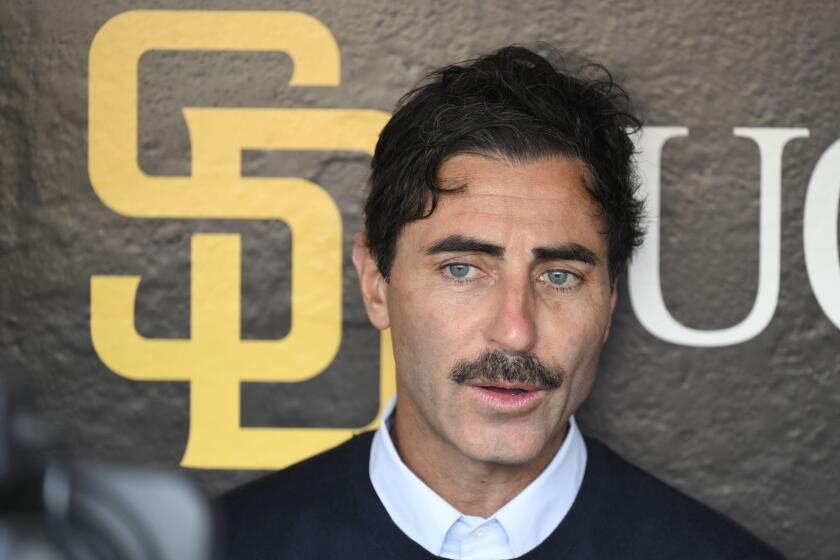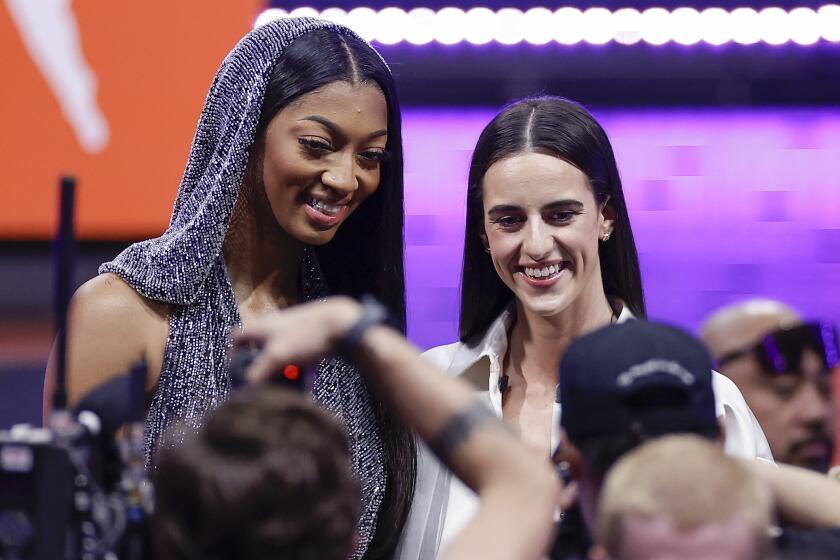Scoring a Chance to Dance
Four years later, people still thank George Teague for what he did on that September afternoon at Texas Stadium.
Teague was playing safety for the Dallas Cowboys on a day when Terrell Owens, then of the San Francisco 49ers, caught two touchdown passes. After the first score, Owens ran to midfield and struck a pose -- arms spread, head back -- while standing on the Cowboy logo, a giant blue star. After the second, he started to do it again.
“It would be like someone coming into your house and standing up on your coffee table,” Teague said, “dancing in front of your kids.”
So Teague ran over and leveled him.
Touchdown celebrations can arouse those sorts of passions.
What began in the 1960s as a minimalist act, a matter of spiking the ball and walking away, has become an elaborate and often choreographed ritual that combines elements of vaudeville, MTV, hip-hop and performance art.
Players gyrate their hips, wag their fingers and waggle their knees. They dive into the stands. They even use props.
Owens once pulled a felt-tipped pen from his sock, autographed the football and handed it to his financial advisor in the stands. New Orleans Saint receiver Joe Horn stashed a cellphone under the goalpost padding before a game, then celebrated a score by calling home.
The quest for newer, more outrageous ways to mark the occasion led Randy Moss of the Minnesota Vikings to pantomime dropping his pants and mooning the crowd in Green Bay last month. A week later, in a game against Moss and the Vikings, receiver Freddie Mitchell of the Philadelphia Eagles pretended to pull a pair of trousers back on.
Some fans can’t wait to see what players will think of next, and the highlight shows cannot get enough. But National Football League officials and the game’s elder statesmen worry that the antics have gotten out of hand. Former Rams defensive lineman Deacon Jones speaks for traditionalists when he grumbles: “I want to watch football, not dance.”
All of this has the image-conscious NFL in a bind, eager to entertain yet mindful of stirring controversy, especially after the trouble last February, when singer Janet Jackson’s breast was bared during the Super Bowl halftime show.
The league monitors touchdown celebrations and has fined players as much as $30,000 for gestures deemed unsporting, such as pointing at an opponent or dancing over a sacked quarterback.
However, fines are not a powerful deterrent in a league whose players earn more than $1 million a year on average, with stars such as Moss and Owens commanding many times that amount.
What’s more, devising rules against end-zone high jinks is like drafting a high-school dress code: There’s no way to anticipate every permutation and close every loophole.
Even with an injured ankle, Owens has been working on a special dance for Super Bowl XXXIX in Jacksonville, Fla., where his team, the Eagles, will play the New England Patriots on Sunday.
“I plan to get there,” he said, referring to the end zone. “I have some different things under consideration.”
No other major sport offers such audacious displays. Basketball and hockey players rarely do more than jump up and down or raise a fist. Baseball has the home-run trot, kept sedate by tradition and a well-established form of retaliation: Any player who acts out while circling the bases is almost certain to get beaned by the pitcher on his next at-bat.
Only soccer comes close to the NFL, with players ripping off their jerseys and sliding across the grass after a goal.
For almost half a century, football players celebrated touchdowns in mundane fashion, following the dictum often attributed to coaching legend Vince Lombardi: “If you get into the end zone, act like you’ve been there before.” Players handed the ball to an official or simply put it on the ground as they jogged to the sideline.
Steve Sabol, president of NFL Films and an aficionado of football history, traces the touchdown celebration to a Sunday in 1960, when Philadelphia quarterback Norm Van Brocklin threw a touchdown pass to receiver Tommy McDonald. McDonald heaved the ball into the stands.
“It was the first incidence of someone doing something other than handing the ball back to the ref,” Sabol said. “And then he got such a reaction from it, he started to do it every time he scored.”
A few years later, Alvin Haymond, a defensive back and kick returner for the Baltimore Colts, celebrated by spreading his hands out in what Sabol describes as “an operatic gesture.” Next came New York Giant receiver Homer Jones and the first spike, somewhere about 1965. Kansas City Chief receiver Elmo Wright soon added a high-stepping stomp.
But it wasn’t until the mid-1970s that touchdown celebrations became spectacles. Houston Oiler receiver Billy “White Shoes” Johnson performed a knee-knocking dance inspired by bluesman Rufus Thomas’ 1969 hit, “Do the Funky Chicken.”
Johnson, now an executive with the Atlanta Falcons, says he wasn’t trying to attract attention, much less put down the opposition. It was, he insists, an expression of pure elation.
“I don’t care how often you score, scoring in the NFL is something to behold,” he said. “It may not ever happen again, so you have to enjoy it while you can.”
The floodgates thrown open, end zones of the 1980s and ‘90s resembled “American Bandstand,” with players eager to show their stuff.
Dallas Cowboy receiver Butch Johnson moon-walked and whipped out imaginary six-shooters in something called the “California Quake.” Cincinnati Bengal running back Ickey Woods did the “Ickey Shuffle,” hopping from foot to foot, passing the ball from one hand to the other, and yelling, “Woo, woo, woo!”
The Washington Redskin receivers convened in the end zone as the “Fun Bunch,” jumping en masse and high-fiving. The St. Louis Rams formed a tight, crouching circle to do the “Bob ‘N’ Weave,” pumping their fists and chanting “Gotta go to work.”
These and other routines seemed harmless enough. Opponents occasionally took exception but there weren’t many complaints when the Green Bay Packers jumped into the first row of the Lambeau Field crowd, a custom that became known as the “Lambeau Leap.” Denver’s militaristic “Mile High Salute” and Atlanta’s awkward, arm-flapping “Dirty Bird” also occasioned mostly smiles.
As the years went by, however, celebrations grew increasingly contrived, boastful and mean-spirited. Harry Edwards, a former UC Berkeley sociology professor who advises 49er coaches and players on various aspects of NFL life, calls it the “well-top-this syndrome.”
Owens -- who grabbed a set of pompoms from a sideline cheerleader and led a cheer for himself during a 2002 game against Green Bay -- is by no means alone in pushing end-zone rituals to the edge of surrealism.
Last season, Horn pretended to machine-gun his teammates, who toppled over on the field, copying a scene from the Oliver Stone film, “Any Given Sunday.”
Cincinnati receiver Chad Johnson posed with a teammate in the end zone as if they were tourists taking a snapshot. Later, against Seattle, he made a throat-slashing gesture to the crowd.
After the league fined him $5,000 for each of the incidents, Johnson concocted something new: Sprinting through the back of the end zone, he reached behind a snow bank and retrieved an orange sign that read: “Dear NFL: Please don’t fine me again.”
That one cost him $10,000.
Ickey Woods seems taken aback by the current end-zone antics. Now coach of a women’s football team in Cincinnati, he mused: “A lot of guys are into the me-me celebrations. My thing was for the fans.”
Jones, a Hall of Fame defensive lineman for the Rams in the 1960s and ‘70s, said in his day it was understood among players that taunting displays were unacceptable. “We didn’t do that because you’re going to spend the night in the hospital,” he said. “Dance in my end zone or spike the ball on me, I take offense to that.”
The NFL has been similarly dismayed.
Reacting in large part to the “Fun Bunch,” the league enacted an “excessive celebration” rule in 1984. Commissioner Paul Tagliabue later relaxed the policy to prohibit only taunting. However, in 2000, the NFL put group celebrations back on the banned list.
Violations can result in an immediate 15-yard penalty and, after the league has reviewed videotape the following week, fines for individual players. Last season, a pair of Houston Texan players paid $5,000 each for spoofing Horn’s cellphone routine, pretending to check under the goalpost, then signaling to the crowd that they could find no phone.
During the 2003 season, fines for choreographed celebrations increased roughly threefold over the previous year, with more than 50 players docked. In cracking down, the NFL gained a nickname: The “No Fun League.”
“We don’t want to discourage players from celebrating.... We never want to do that,” said Mike Pereira, director of officiating. “But we want them to do it in such a way that’s spontaneous, good, reflects the attitude of the team.”
Curbing objectionable behavior has been difficult, if only because officials are hard-pressed to predict what players might try next. This season’s “Game-Related Player Conduct Rules” is expansive.
Forbidden acts include, but are not limited to, “sack dances, home run swing, ‘Incredible Hulk,’ spiking the ball, spinning the ball, throwing or shoving the ball, pointing, pointing the ball, verbal taunting, military salute, standing over an opponent if prolonged or with provocation, dancing.”
Jones would like to see a simpler rule: “Hand the ball to the referee and get back to the huddle or the sidelines. Because it ain’t going to do nothing but escalate. Guys are going to be doing all kind of things. It’s already gotten down to pulling my pants down.... How much worse can it get?”
Significantly worse, says Edwards, who nonetheless was encouraged that Moss only pretended to moon the crowd.
“We haven’t reached the basement yet,” he said. “We’re on the steps to the basement, but we haven’t reached the basement yet.”
Back when he played college football, when his Alabama team faced Miami in the 1993 Sugar Bowl, George Teague decided that if he returned an interception for a touchdown, he would strike the Heisman Trophy pose -- one knee up, one arm extended -- as a not-so-subtle dig at Miami quarterback Gino Torretta, who had won the award a few weeks earlier.
Sure enough, Teague got his interception and touchdown, but “my adrenaline level was so up and the fans were going so crazy, I just ran around and threw the ball down.”
Now a high school coach near Fort Worth, Teague, 33, has a soft spot for end-zone theatrics. Despite what happened with Owens on that distant afternoon, he worries that if the NFL keeps imposing restraints, the league will become as mechanical as that children’s game in which tiny plastic players jitter around on a vibrating metal board.
Let the guys celebrate, he says, as long as they keep it brief.
“Just do your little dance, your little hand motions, your ‘Worm’ or whatever, and be on your way,” he said. “Don’t make it a personal attack on someone else.”
And whatever you do, he adds, no dancing on the big blue star.
Times staff writer Sam Farmer in Jacksonville, Fla., contributed to this report.
More to Read
Go beyond the scoreboard
Get the latest on L.A.'s teams in the daily Sports Report newsletter.
You may occasionally receive promotional content from the Los Angeles Times.
